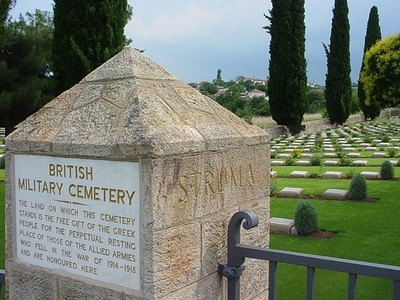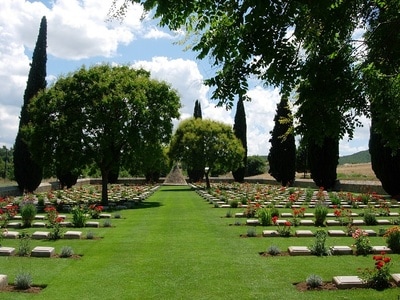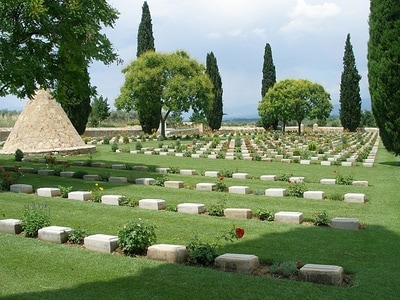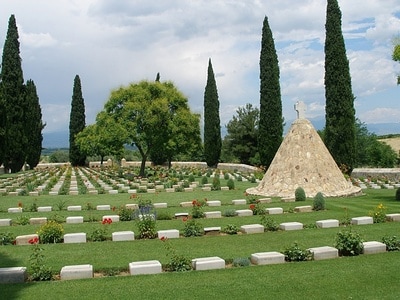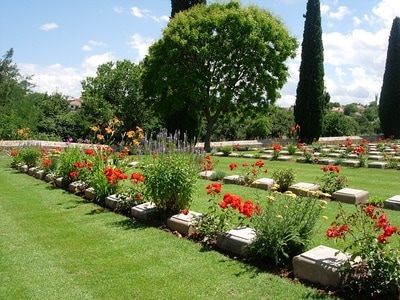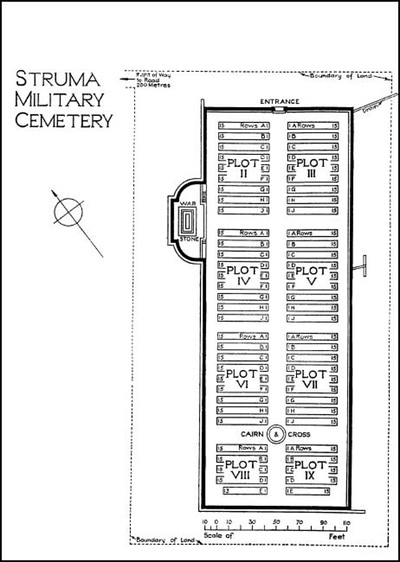STRUMA MILITARY CEMETERY
Nigrita
Greece
Location Information
E79 is the main road between Thessaloniki and Serres/Bulgaria. Approximately 75km from Thessaloniki, take the exit marked Strimoniko, Kalokastro and Nigrita. Proceed for around 1 km until you reach the crossroads at Strimoniko. Turn left for Kalokastro and Nigrita and proceed for approximately 3 km until you come to the junction of Livadochori, Nigrita where the cemetery is signposted. Turn right onto the agricultural road and follow this for 400 metres and turn left for access to the cemetery.
Visiting Information
The Cemetery is permanently open and may be visited at any time.
Historical Information
The Struma River flows through Bulgaria southward to the Greek frontier, then south-east into the Aegean Sea. From the Allied base at Salonika, a road ran north-east across the river to Seres, and it was this road that the right wing of the Allied army used for the movements of troops and supplies to the Struma front during the Salonika Campaign.
In the autumn of 1916, the 40th Casualty Clearing Station was established not far from the road near the 71 Kilometre stone and the cemetery made for it was originally called Kilo 71 Military Cemetery.
The original plot, Plot I, was set too close to a ravine and the graves in it were moved after the Armistice to the present plots VIII and IX. The remainder of the cemetery consists almost entirely of graves brought in from the battlefields, from the churchyards at Homondos, Haznatar and Kalendra, and from little front-line cemeteries (established by Field Ambulances or Battalions), of which the chief were those at Ormanli (24 burials), Dolab Wood (17 burials) and Big Tree Well (on the right bank of the Struma, opposite Ormanli; 17 burials).
Struma Military Cemetery contains 947 Commonwealth burials of the First World War, 51 of them unidentified. There are also 15 war graves of other nationalities.
Cemetery pictures used with the permission of the Commonwealth War Graves Commission
E79 is the main road between Thessaloniki and Serres/Bulgaria. Approximately 75km from Thessaloniki, take the exit marked Strimoniko, Kalokastro and Nigrita. Proceed for around 1 km until you reach the crossroads at Strimoniko. Turn left for Kalokastro and Nigrita and proceed for approximately 3 km until you come to the junction of Livadochori, Nigrita where the cemetery is signposted. Turn right onto the agricultural road and follow this for 400 metres and turn left for access to the cemetery.
Visiting Information
The Cemetery is permanently open and may be visited at any time.
Historical Information
The Struma River flows through Bulgaria southward to the Greek frontier, then south-east into the Aegean Sea. From the Allied base at Salonika, a road ran north-east across the river to Seres, and it was this road that the right wing of the Allied army used for the movements of troops and supplies to the Struma front during the Salonika Campaign.
In the autumn of 1916, the 40th Casualty Clearing Station was established not far from the road near the 71 Kilometre stone and the cemetery made for it was originally called Kilo 71 Military Cemetery.
The original plot, Plot I, was set too close to a ravine and the graves in it were moved after the Armistice to the present plots VIII and IX. The remainder of the cemetery consists almost entirely of graves brought in from the battlefields, from the churchyards at Homondos, Haznatar and Kalendra, and from little front-line cemeteries (established by Field Ambulances or Battalions), of which the chief were those at Ormanli (24 burials), Dolab Wood (17 burials) and Big Tree Well (on the right bank of the Struma, opposite Ormanli; 17 burials).
Struma Military Cemetery contains 947 Commonwealth burials of the First World War, 51 of them unidentified. There are also 15 war graves of other nationalities.
Cemetery pictures used with the permission of the Commonwealth War Graves Commission
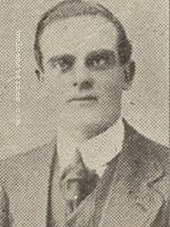
1257 Sapper
A. Holbrook
Royal Engineers, 1st (Wessex) Field Coy.
30th September 1916, aged 34.
Plot III. E. 3.
Brother of F. Holbrook, of 5, Hanover Terrace, Snow Hill, Bath.
A. Holbrook
Royal Engineers, 1st (Wessex) Field Coy.
30th September 1916, aged 34.
Plot III. E. 3.
Brother of F. Holbrook, of 5, Hanover Terrace, Snow Hill, Bath.
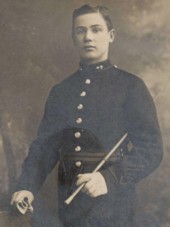
75392 Lance Bombardier
William Robert John Savill
18th Bty, 3rd Bde. Royal Field Artillery
21st June 1918, aged 22.
Image courtesy of niece, Edith Morley.
William Robert John Savill
18th Bty, 3rd Bde. Royal Field Artillery
21st June 1918, aged 22.
Image courtesy of niece, Edith Morley.

